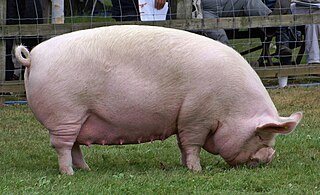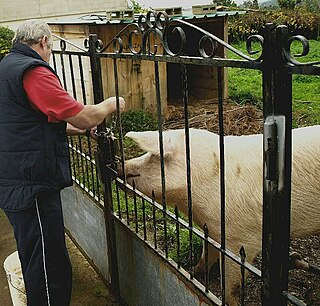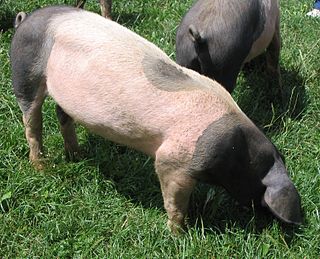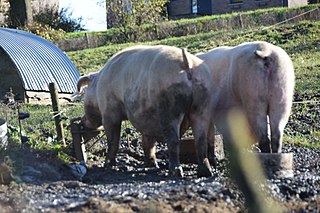Related Research Articles

A landrace is a domesticated, locally adapted, traditional variety of a species of animal or plant that has developed over time, through adaptation to its natural and cultural environment of agriculture and pastoralism, and due to isolation from other populations of the species. Landraces are generally distinguished from cultivars, and from breeds in the standardized sense, although the term landrace breed is sometimes used as distinguished from the term standardized breed when referring to cattle.

Vietnamese Pot-bellied is the exonym for the Lon I or I pig, an endangered traditional Vietnamese breed of small domestic pig.

The Danish Landrace is a medium to large breed of pig, white in colour with long bodies, fine hair, long snouts, and heavy drooping ears. They are bred for pork production. There are two distinct varieties, the white and the piebald

Pig shows are an event where pigs are evaluated for their quality. They are evaluated on a multitude of things which include composition, capaciousness, and skeletal integrity along with general appearance and conformation to their respective breed. Owners buy or raise their pigs from small piglets and spend time learning what the pig needs to make it the best possible. You can switch up compositions of a pig by simply changing what and how you feed them. Other names for a pig show include swine show and hog show. A pig show is frequently part of a larger agricultural show. During the agricultural show pigs may be shown, as well as cattle, goats, and sheep.

The Berkshire is a British breed of pig. It originated in the English county of Berkshire, for which it is named. It is normally black, with some white on the snout, on the lower legs, and on the tip of the tail.
A landrace is a type of domestic animal or plant adapted to the natural and cultural environment in which it originated, with minimal selective breeding. Some have "landrace" in the names:

The Middle White is a British breed of domestic pig. It originated in Yorkshire, and derived from the Large White and the now-extinct Small White. It was recognised in 1852, and the first herd-book was published in 1884. It is a porker, reared for fresh pork, and is characterised by a short and sharply-upturned snout. After the Second World War it came close to extinction; although numbers have recovered somewhat, it is listed by the Rare Breeds Survival Trust as "priority" – the highest level of risk.

The British Lop is an old pig breed native to the United Kingdom. A large, white pig, it is named for its large ears which hang over its face. The breed was originally developed as an amalgamation of several local lop-eared breeds in England, and came to be known as the British Lop in the 1960s.

The Welsh is a breed of domestic pig native to Wales. It is a large white breed known for its hardiness in outdoor (extensive) farming, its long, pear-shaped body and its lop-ears. The breed was first mentioned in the 1870s, and after the Howitt committee report in 1955, became the third most common sire in the United Kingdom after the Large White pig and British Landrace pig. The Welsh pig experienced a decline in numbers in the late twentieth century because consumer demands had changed and the carcase was considered too fatty. In 2005 the breed was considered endangered and later came under the auspices of the Rare Breeds Survival Trust. Since then numbers have expanded somewhat, and by 2012, the registered breeding herd had increased to over 1000 animals.

The Ossabaw Island Hog or Ossabaw Island is a breed of pig derived from a population of feral pigs on Ossabaw Island, Georgia, United States. The original Ossabaw hogs are descended from swine released on the island in the 16th century by Spanish explorers. A breeding population has been established on American farms off the island, but they remain a critically endangered variety of pig.

The Italian Landrace is an Italian breed of domestic pig. It derives from the Danish Landrace breed developed in Denmark at the end of the nineteenth century. Stock was imported into Italy after the Second World War. The breed has been selected principally for suitability for the production of prosciutto crudo. It is, after the Large White Italiana, the second-most numerous pig breed in Italy. The breed standard is issued by the Ministero delle Politiche Agricole Alimentari e Forestali, the Italian ministry of agriculture and forestry; the herdbook is kept by the Associazione Nazionale Allevatori Suini, the national pig-breeders' association.

The Swedish Landrace is the leading breed of pig in Sweden. They have heavy drooping ears and a white coat. The Swedish strain of the Landrace pig originated from importations from neighboring countries, particularly Denmark. The Swedish Landrace have attracted attention in the United States and other nations in recent years.
The Cumberland was a breed of domestic pig that originated in the North of England; it was used to produce local delicacies like the Cumberland sausage and Cumberland ham. The breed became extinct in 1960, after changes in farming methods and a demand for less fatty meat led to it falling out of favour.

The Swabian-Hall swine is a breed of domestic pig originating from Schwäbisch Hall in Baden-Württemberg, Germany. It is a large pig, white in the centre with a black head and rear and narrow grey bands at the transition from white to black skin. They have large litters averaging more than nine piglets.

The British Landrace is a British domestic breed of pig and one of the most popular in the United Kingdom. It is white with heavy drooping ears that cover most of the face and is bred for pork and bacon. The breed originated in the 1949 importation of 12 landrace pigs from Scandinavia — four boars and eight gilts. In 1950, the British Landrace Pig Society was formed and it opened a herd book for the first offspring born from the imported 12. They created the first pig testing scheme with a testing station at the village of Stockton-on-the-Forest in North Yorkshire.
The Lacombe is a breed of domestic pig native to Canada. Named for the Lacombe Research and Development Centre in Lacombe, Alberta, the breed was the first strain of livestock developed in the country.

The Belgian Landrace, also known as the Improved Belgian, Belgian Improved Landrace, and the Belgian Lop-eared, is a breed of domestic pig from northern Belgium. It was created from importing English breeds and improving them until they were "graded up" to the German Improved Landrace from 1930 to 1945 and then breeding them with the Dutch Landrace in 1945. Other breeds were also incorporated into the bloodline to strengthen it, such as with ones from Luxembourg in 1955, Germany in 1971, and the Czech Republic in 1974. Used in many different countries, the Belgian Landrace is also one of the "four major commercial breeds" in France.

The Göttingen minipig is a breed of small swine. The Göttingen minipig is the smallest domestic pig breed known in the world; as an adult, they weigh around 35 kg (77 lb). Beside being known for their exceptionally small size, the Göttingen minipigs are known for their docile nature and very clean and well-characterized health status. Raising of this breed began in the late 1960s at the Institute of Animal Breeding and Genetics at the University of Göttingen, Germany, by crossbreeding the Minnesota mini-pig, the Vietnamese pot-bellied pig, and the German Landrace pig. Göttingen minipigs are highly favored as pets, however, the breed was specifically developed for biomedical research. Today, they are extensively bred at four separate locations globally.
The term Landrace pig or Landrace swine refers to any of a group of standardized breeds of domestic pig, and in this context the word Landrace is typically capitalized. The original breed by this name was the Danish Landrace pig, from which the others were derived through development and crossbreeding. The breed was so-named because the foundation stock of the Danish Landrace were specimens from the local, free-breeding, non-pedigreed stock of swine, i.e. the regional landrace native to Denmark. The modern breeds are not themselves landraces, since they are formal breeds maintained through selective breeding rather than natural selection. The establishment and spread of the Danish breed gave the word landrace to the English language. Sources from the mid-20th century often mean the Danish Landrace swine in particular when referring to "Landrace" pigs, as most of the others had not been developed yet.
The Dutch Landrace pig is a standardized breed of domestic pig originating in the Netherlands. The breed was developed from the native landrace of pigs of the area, crossbred with strains from neighboring counties. The Dutch Landrace is considered "a meaty and efficient breed". The breed is unusually responsive to the halothane test, which can be used to weed out individuals with low projected survivability and meat production.